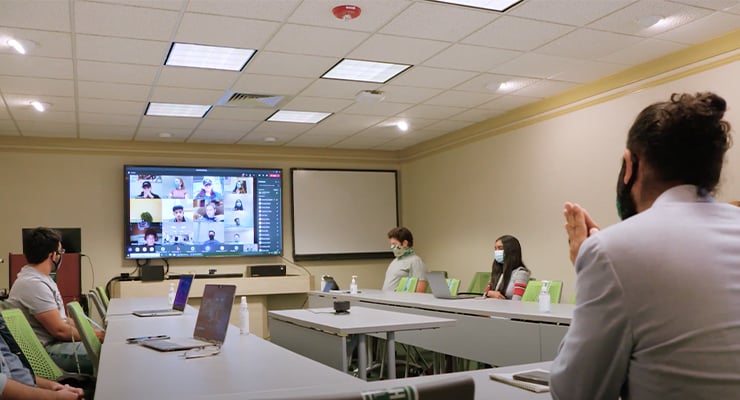What Are Hybrid Classes and How Do You Succeed in Them?
By Raman Sachdev, PhD | Last Updated: Mar 5, 2025

The fall 2020 semester in higher education brings with it a new educational format: hybrid classes. If you’ve found yourself wondering “What are hybrid classes?” and how do you succeed in them, read on. I’ll explain the nuts and bolts of what it’s like to participate in a partially online, partially in-person class. I’ll also provide you with some tips and best practices to help you succeed in a hybrid class.
The Hybrid Class Setup: Remote and In-Person Learning
Having taught a pilot hybrid class during the summer 2020 semester, I experienced firsthand what it’s like to lead a discussion-based class and guide students in this unique learning environment. So, what does the classroom actually look like?
If you attend the class in person, you’ll likely be one of a relatively small number of students within the classroom (somewhere between 25 percent and 50 percent of the room capacity). In the classroom, you’ll be seated at least six feet apart from other students, and you’ll be required to wear a face mask. These safety measures have been put in place at colleges and universities around the country to help limit the spread of COVID-19. If you’re joining in remotely, then these procedures won’t apply to you.
What about the technology within the classroom and for the students joining in remotely? Whether you’re taking the course online or in person, you’ll most likely be required to have access to a functioning computer or tablet that has the ability to perform two important functions:
- Run a video conferencing program, like Zoom or Microsoft Teams (both the audio and the video components, including the use of the computer’s internal microphone)
- Connect to the internet at a high speed so that you can be a part of the classroom experience without encountering excessive lags or breaks in connectivity
In a class of about twenty students, let’s say ten registered remotely and ten attending in person. Here’s a way to imagine and anticipate what a typical class day would look like:
- All twenty students would log on to the virtual meeting at the designated class time, making sure to mute their microphones (see tips below).
- Once logged on, the instructor of the class would speak to the classroom of students, whether in a lecture or discussion-based format.
- Through the use of both a large projector screen and a classroom microphone, the instructor and the students within the classroom will be able to see and interact with the remote students logged on to the virtual meeting.
After some initial awkwardness and anxiety due to the novelty and unconventionality of the setup, the classroom experience should become manageable and even enjoyable.

Tips for Success in Hybrid Classes
Whether you register as a remote learner or as an in-person student, following the guidance available (for example, USF’s Academic Success Tips or ATLE’s Student Success Checklist) will help you to do well in hybrid classes. Based on my experience teaching a hybrid course, along with what I’ve learned from the experiences of my students, I’ve put together a shortlist of tips and best practices to help you succeed:
- Each time you log on to your class meeting, make sure to mute your computer or tablet microphone. Not doing so can create a distraction and interrupt your in-class peers and instructor. Additionally, it’s a good idea to always have your video feed turned on, as doing so both lets your instructor know that you’re actually joining in and enhances the feel of a full classroom of students.
- If you’re logged on remotely, use the Raise Your Hand feature when you’d like to ask a question or contribute to the class discussion. This will signal to your instructor in the classroom that you’d like to chime in. When the instructor calls on you, unmute your audio. After you’ve finished speaking, mute your audio and Lower Your Hand. Following these steps will ensure a smooth flow both technologically and pedagogically.
- If you’re attending the class in person, it’s a good idea to raise your hand before being called upon or speaking. Like point 2. above, doing so will make for a smooth and organized discussion.
- Finally, be patient and tolerant. These are extraordinary times, and both instructors and students should accept that there will inevitably be challenges, technologically and otherwise, as we all try to adapt to this new way of learning. Remember that we’re all in this together, that we all want our educational system to thrive, and that we will get through this together.



